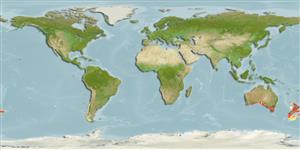Environment: milieu / climate zone / depth range / distribution range
Sinh thái học
Biển; Thuộc về nước lợ Sống nổi và đáy; Ở đại duơng, biển (Ref. 51243); Mức độ sâu 27 - 650 m (Ref. 58489). Temperate; 32°S - 55°S, 115°E - 71°W
Eastern Indian Ocean: southern Australia (from South Australia to New South Wales and Tasmania). Southwest Pacific: New Zealand and Kermadec Island. Southeast Pacific: Chile (Ref. 9068).
Length at first maturity / Bộ gần gũi / Khối lượng (Trọng lượng) / Age
Maturity: Lm 40.0 range ? - ? cm
Max length : 66.0 cm TL con đực/không giới tính; (Ref. 9563); common length : 51.0 cm FL con đực/không giới tính; (Ref. 9049); Tuổi cực đại được báo cáo: 15 các năm (Ref. 9072)
Adults are usually demersal on the continental shelf and slope, occasionally occurring at the surface; subadults in surface waters, sometimes entering bays, while juveniles occur offshore (Ref. 9563). Reported from depths of 27 m (Ref. 58489) to 600 m (Ref. 9563). They form feeding and spawning aggregations. Spotted warehou are schooling species, usually aggregating close to the sea bed (Ref. 26498) although there is some evidence that they move into the middle water column at night (Ref. 30459). During spring-summer in New Zealand, adult and juvenile fish migrate to feed along the continental slope off the east and southeast coast of the South Island (Ref. 9072). Adults mainly eat planktonic tunicates (Ref. 6390).
In New Zealand, spotted warehou are thought to undertake a southerly migration following spawning on the Chatham Rise in spring (Ref. 26998).
Paulin, C., A. Stewart, C. Roberts and P. McMillan, 1989. New Zealand fish: a complete guide. National Museum of New Zealand Miscellaneous Series No. 19. 279 p. (Ref. 5755)
IUCN Red List Status (Ref. 130435)
Threat to humans
Harmless
Human uses
Các nghề cá: Tính thương mại
Các công cụ
Special reports
Download XML
Các nguồn internet
Estimates based on models
Preferred temperature (Ref.
123201): 9.7 - 15.4, mean 13 °C (based on 84 cells).
Phylogenetic diversity index (Ref.
82804): PD
50 = 0.5156 [Uniqueness, from 0.5 = low to 2.0 = high].
Bayesian length-weight: a=0.00955 (0.00485 - 0.01879), b=3.13 (2.95 - 3.31), in cm total length, based on LWR estimates for this species & (Sub)family-body (Ref.
93245).
Mức dinh dưỡng (Ref.
69278): 3.5 ±0.41 se; based on food items.
Thích nghi nhanh (Ref.
120179): Trung bình, thời gian nhân đôi của chủng quần tối thiểu là 1.4 - 4.4 năm (K=0.36; tm=3-4; tmax=15).
Prior r = 0.70, 95% CL = 0.46 - 1.05, Based on 2 stock assessments.
Fishing Vulnerability (Ref.
59153): Low to moderate vulnerability (33 of 100).
Climate Vulnerability (Ref.
125649): High to very high vulnerability (74 of 100).
Nutrients (Ref.
124155): Calcium = 21.4 [14.6, 40.2] mg/100g; Iron = 0.316 [0.197, 0.529] mg/100g; Protein = 17.6 [15.7, 19.5] %; Omega3 = 0.733 [0.427, 1.296] g/100g; Selenium = 22.4 [10.3, 42.4] μg/100g; VitaminA = 17.7 [6.7, 50.1] μg/100g; Zinc = 0.534 [0.400, 0.715] mg/100g (wet weight); based on
nutrient studies.
